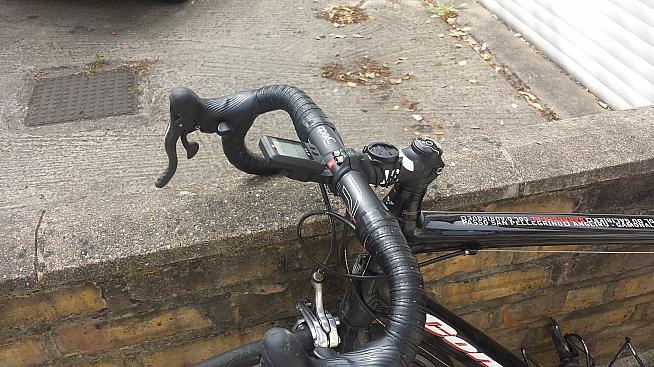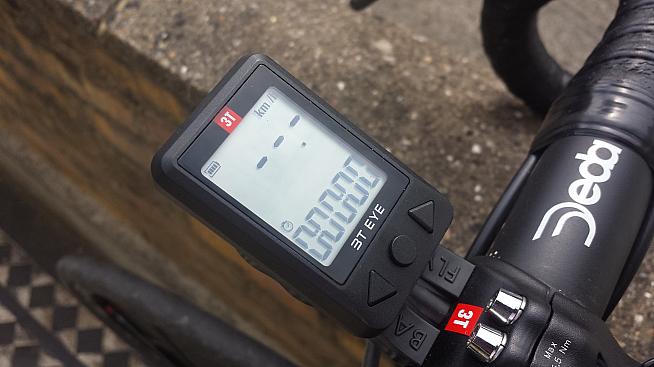3T are a big company in cycling. They supply parts to BMC, MTN Qhubeka and Bigla Pro Cycling. They make bars, stems, forks, seatposts and wheels from their factories in Taiwan and you see their parts on a lot of good quality bikes. Now they've branched out into the world of cycle computers, taking on the likes of Garmin.
The concept of the 3T Eye is that it is a low cost cycling computer. Instead of paying £300+ for a Garmin, the 3T Eye costs £99.99 (that's the Recommended Retail Price but you can actually get one for £90 at online retailers). The savings come because you are downloading the software onto your smartphone and then the smartphone connects to the 3T Eye by Bluetooth and displays all the data about your speed, time elapsed, elevation etc in front of you while you ride. It can also connect to your heart monitor, cadence monitor and even power meters, via the ANT+ technology.
The 3T eye unit is certainly small and not going to add a great deal of weight to your bike. At 25g it is probably one of the lighest devices out there. It comes with what they call a 'barfly' which mounts onto the stem so the computer is sitting out in front of you on an extension.
The first irritation was that the 3T Eye only works with a 3T stem. Now, I don't know about you but if you are in the market for a 'value' cycling computer, the last thing you want to do it have to buy a new stem for your bike in order to be able to fit it properly. Okay, a stem isn't hugely expensive (you're looking at £25 to £30) but you probably don't factor that into your calculations when working out whether to buy a bike computer. Add in the fact that you then actually have to replace your stem - which actually isn't the easiest thing in cycling mechanics to do correctly (as any bike shop will tell you) - and it is a factor in deciding whether to buy a 3T Eye. Clearly if you already have a 3T stem - and lots of people do as it's a popular make - then this is irrelevant.

The second irritation is that it only works with an Apple phone. Now, I used to have an Apple phone but for work reasons I now have an Android. And so do the majority of phone users in the world. It may be that the sort of people who can afford to pay £3000 for a carbon bike are also the sort of people who have an Apple phone. But to my mind they are also the sort of people who can shell out £300 for a bike computer (especially if they have spent £1000+ on a power meter).
Anyway, the website said that an Android version of the software was coming soon. I received the 3T Eye for review in July and took it out for a 50km test ride in the first week, borrowing my wife's iPhone to see what it was like. More of that in a second. But I thought before writing a review I would wait until the Android software was released, allowing me to give an assessment of how it works for more than 50% of potential users. However we have now reached November and the Android software is still not available, which would have left me slightly peeved had I bought the 3T Eye in anticipation of the Android version being on the way, especially as the 3T website says that it exists.
So, what was it like when I actually did test it? It was fine. It does pretty much what you would expect. It shows your speed, distance travelled, time elapsed and heart rate (the synching of the heat rate monitor to the 3T Eye was easy). The unit is easy to read and you have the basics that you need on a ride. However the fatal flaw is that the 3T Eye eats phone batteries at a fearsome rate. On a two hour ride my wife's iPhone went from 97% to 28%. If I had been riding my normal 100km Wednesday morning ride then the phone would have been dead by the time I was 70km into it. So I would have no data outputs for my riding but, far more crucially, I would no longer have a working phone to use in emergencies or if I had a double puncture and needed to call someone to pick me up. Let me make this clear, I wasn't running anything else on her phone (email, Strava, messaging systems, Fifa 2015 etc), the speed of drain appeared to be entirely down to the 3T software and the use of Bluetooth.

I don't enjoy writing bad reviews but I can't recommend anyone buys the 3T Eye. I am not a big fan of Garmins - I find they are far from instinctive to use and I have concerns about whether some of the data is as accurate as it could be - but at the moment I will be sticking to my Edge 800 and having Strava in my back pocket rather than moving over to 3T.
It feels to me that this was a project conceived by marketeers who thought 'there must be a gap in the market for a cheap, lightweight bike computer'. In this respect they may be right - there are similar products on the market, like the Wahoo RFLKT+ reviewed back in October 2014. However, I wonder if less thought went into how it would work and who might actually buy it. Perhaps this is attempt number one and an upgrade is on the way - if so, it will be interesting to see what a new, improved version might look like.
0 Comments





